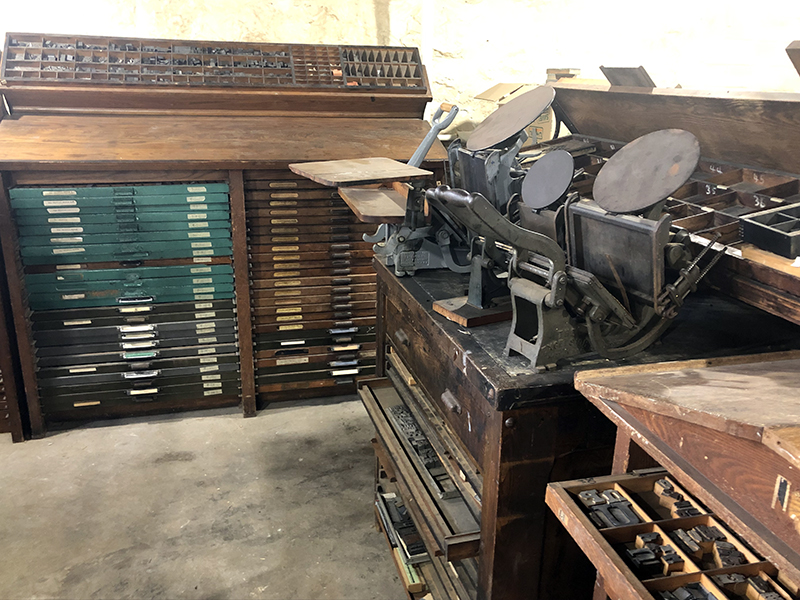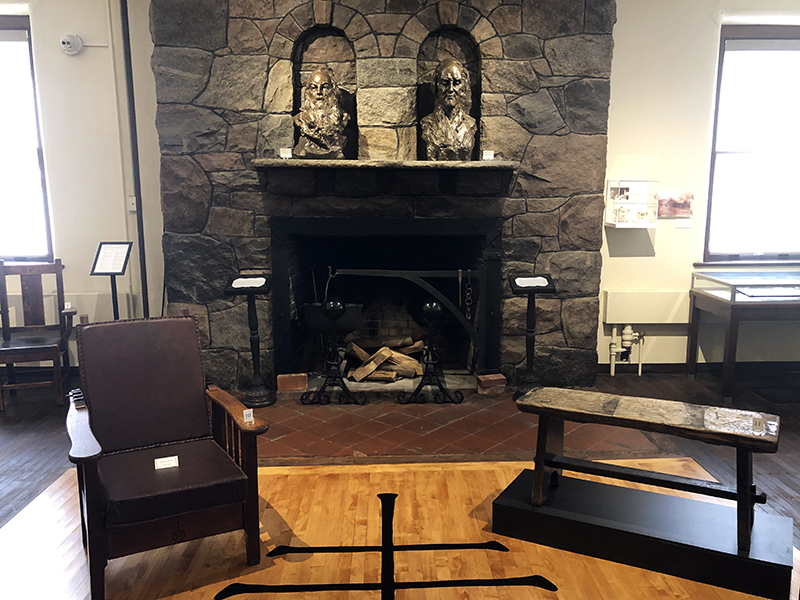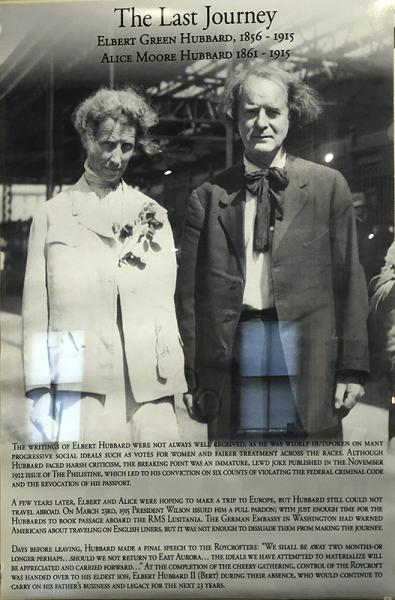A Visit to Roycroft Campus, Cradle of the Arts & Crafts Movement
-by Carol White Llewellyn
 About an hour-and-a-half from Rochester, or a hop, skip and jump from Buffalo in East Aurora, you’ll find a tribute to the late 19th and early 20th Century crafts guilds.
About an hour-and-a-half from Rochester, or a hop, skip and jump from Buffalo in East Aurora, you’ll find a tribute to the late 19th and early 20th Century crafts guilds.
The Roycroft Campus was started by Elbert Hubbard in 1897. Born in Illinois in 1856, Hubbard had such success as a salesman for Larkin Soap—which brought him to East Aurora, NY—that at a very young age, he found himself to be a wealthy man.
After visiting William Morris' Kelmscott Press in England, he followed his desires and got into writing and publishing, launching Roycroft Press. The press published his two magazines, The Philistine—A Periodical of Protest, and The FRA—A Journal of Affirmation. Both gave voice to Hubbard's liberal viewpoints. One of the essays he wrote, A Message to Garcia, espousing the importance of individuality and conscientiousness toward work, sold somewhere around 40 million copies. On the campus where he moved the printing facility, he built the Roycroft Inn (1897)—which underwent an $8 million dollar facelift in the ‘90s—to accommodate the many people who began visiting the illustrious printer.
 Since the inn needed furniture and décor items, he quickly opened a copper shop (1902) and furniture shop (1904), to hand-craft furnishings. He hired and trained craftspeople for all the positions—both men and women who were paid equal salaries for the jobs they performed as illustrators, illuminators, binders, painters, inn operators and more. These “Roycrofters,” as they were called, influenced American architecture and design in the early 20th century.
Since the inn needed furniture and décor items, he quickly opened a copper shop (1902) and furniture shop (1904), to hand-craft furnishings. He hired and trained craftspeople for all the positions—both men and women who were paid equal salaries for the jobs they performed as illustrators, illuminators, binders, painters, inn operators and more. These “Roycrofters,” as they were called, influenced American architecture and design in the early 20th century.
Today, the campus is maintained by a non-profit organization that preserves and restores the heritage of this homage to the Arts & Crafts movement.
We started in the Power House—reconstructed in 2012 after a devastating fire—which doubles as visitors center and event space, featuring introductory displays and exhibits. This building originally furnished electricity and heat for the campus. We were fortunate to have Reid as our docent. In addition to giving tours, which is clearly one of his passions, he is the Campus’ archivist, so he regaled us with a wealth of knowledge and interesting facts.
A fter a quick stop outside to get an overview of the campus, we headed to the multi-level Print Shop, which originally housed 23 printing presses. Today, a number of the original presses are still onsite, and you have the opportunity to meander through them, looking at the typesetting equipment, the letter storage boxes, and the typefaces used. On one floor in the Print Shop is the Museum, in which you’ll find a variety of historic artifacts, including furniture and lamps from the Movement, and photos of Hubbard and his two wives. Reid shared what would have been a scandalous story during Hubbard’s time of how he left his first wife to follow and marry a woman who had been a guest in the Hubbard home.
fter a quick stop outside to get an overview of the campus, we headed to the multi-level Print Shop, which originally housed 23 printing presses. Today, a number of the original presses are still onsite, and you have the opportunity to meander through them, looking at the typesetting equipment, the letter storage boxes, and the typefaces used. On one floor in the Print Shop is the Museum, in which you’ll find a variety of historic artifacts, including furniture and lamps from the Movement, and photos of Hubbard and his two wives. Reid shared what would have been a scandalous story during Hubbard’s time of how he left his first wife to follow and marry a woman who had been a guest in the Hubbard home.
The museum had a collection of numerous original publications, and much fascinating memorabilia, including a photo of the ill-fated Hubbard and his second wife, Alice, who had the misfortune to be traveling aboard the Lusitania when it was sunk by a German U-boat in 1915. Today, the building also houses a variety of artists’ studios.
My husband and I had opted for the one-hour tour, so this is where our official tour ended, but we then entered the Copper Shop, which has been turned into a shop and gallery, with museum-quality, artisan-crafted gifts. Many of the items are available for purchase online.
 Also onsite is a building that once housed the furniture shop and bindery, and which is now the home of Roycroft Campus Antiques. The campus’ Chapel, built in 1899, is now open only for events and lectures.
Also onsite is a building that once housed the furniture shop and bindery, and which is now the home of Roycroft Campus Antiques. The campus’ Chapel, built in 1899, is now open only for events and lectures.
We wandered over to the Roycroft Inn, decorated in furniture and décor from the sleek and traditional Arts and Crafts Movement. Visitors to the Inn will be delighted with accommodations ranging in size from an elegant guest house room up through something as large as a five-room suite.
We were there on a Saturday morning, so I’m unable to share thoughts on the Inn’s dining, which is open for dinner five nights a week, as well as for Sunday brunch.
In addition to the one-hour and one-and-a-half hour tours, the Roycroft Campus also offers a variety of classes throughout the year, a lecture series, and events, including the Roycroft Campus & Antique Art Show in June, the Fall Festival in early October, and the Holiday Art Show in early December.
 The Roycroft Campus is open Tuesday through Saturday from 11am (EST) to 5pm (EST), excluding New Year’s Day, Easter, Memorial Day, the Fourth of July, Labor Day, Thanksgiving, and Christmas. The Inn is open 365 days a year. The one-hour tour currently takes place from Tuesday through Saturday at 11:30 ($15 admission, $10 for students and military with ID). The One-and-a-half hour tour currently takes place the same days at 2:00 pm ($20 admission, $15 for students and military with ID). There is also several in-depth specialty tours. We suggest that you call the Roycroft Campus or book your tour in advance.
The Roycroft Campus is open Tuesday through Saturday from 11am (EST) to 5pm (EST), excluding New Year’s Day, Easter, Memorial Day, the Fourth of July, Labor Day, Thanksgiving, and Christmas. The Inn is open 365 days a year. The one-hour tour currently takes place from Tuesday through Saturday at 11:30 ($15 admission, $10 for students and military with ID). The One-and-a-half hour tour currently takes place the same days at 2:00 pm ($20 admission, $15 for students and military with ID). There is also several in-depth specialty tours. We suggest that you call the Roycroft Campus or book your tour in advance.
If you enjoy history or architecture and décor, the Roycroft Campus offers a fascinating look into the turn-of-the-Century reformist Arts and Crafts movement, and the progressive mind of a man who made his mark on Western New York State and the country.

Photos above:
Top: Powerhouse which houses the Visitors Center and Event Facility
Second down: A view of the Print Shop
Third down: A view of some of the presses, the letter storage and the typesetting area
Fourth down: Inside the Museum
Fifth Down: Elbert Hubbard and his wife Alice just prior to the sinking of the Lusitania
Bottom: The Copper Shoop, which now houses the Shop and Gallery
By Carol White Llewellyn, Editor of Beyond the Nest.

